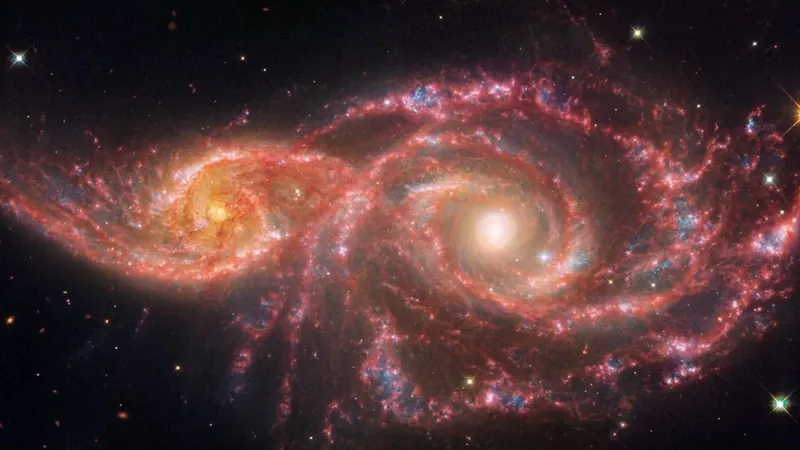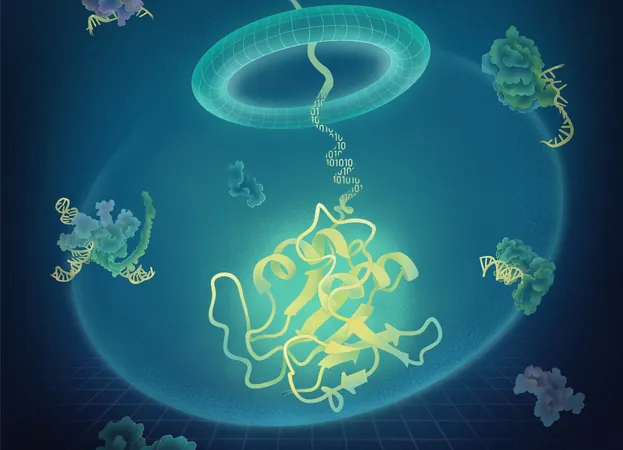
5 Groundbreaking Discoveries by the James Webb Space Telescope in 2024 That Could Change Everything!
2024-12-28
Author: Jia
Introduction
Since its incredible launch on Christmas Day in 2021, the James Webb Space Telescope (JWST) continues to push the boundaries of our understanding of the universe. The year 2024 has been particularly remarkable, with several findings that promise to reshape the foundations of astrophysics. Here are five standout instances where JWST has stunned scientists and redefined our cosmic knowledge.
1. Astonishingly Large Early Galaxies
JWST was primarily designed to uncover the secrets of the universe's earliest galaxies. The telescope's powerful infrared capabilities have allowed astronomers to spot these ancient celestial structures, revealing that they are not only larger but also far brighter than scientists had anticipated. This discovery significantly alters our understanding of galaxy formation, indicating that the early universe was a lot busier and more dynamic than previously believed.
This rapid growth of galaxies—occurring within just a few hundred million years after the Big Bang—poses a deep mystery. Experts are now eager for future observations from JWST to unearth the mechanics behind this astonishingly quick galaxy formation, as it challenges established cosmological models.
2. Discoveries of Massive Black Holes
In 2024, JWST made headlines with its discovery of colossal black holes dating back to only 740 million years after the Big Bang. Two such supermassive black holes, each about 50 million times the mass of our Sun, were observed in a dramatic cosmic collision.
The emergence of these gigantic black holes early in the universe is perplexing since current theories suggest that black holes originate from the remnants of massive stars. The complexity arises from the fact that these tiny black hole 'seeds' presumably needed to grow at an extraordinary pace and merge frequently to achieve their supermassive status. The origins of these early black holes may provide crucial insights into the nature of the universe's evolution.
3. The Persistent Hubble Tension
The Hubble tension has posed a significant challenge for cosmologists, with varied measurements of the universe's current expansion rate causing a stir in the scientific community. Some methods yield a higher rate reflecting the early universe, while others from later stages show lower rates.
In 2024, JWST confirmed the Hubble tension, adding further weight to the ongoing debate. While the differences could stem from measurement inaccuracies, they also hint at deeper issues involving dark energy and the fabric of spacetime itself. As astronomers search for an accepted explanation, the JWST's role in further refining these measurements will be pivotal.
4. The Early Presence of Carbon
The elements necessary for life—hydrogen, oxygen, carbon, nitrogen, and phosphorus—are thought to have been formed in the hearts of stars. A significant revelation from JWST was the detection of a cloud of carbon existing just 350 million years after the Big Bang.
This finding dramatically reshapes our timeline of life's potential emergence in the universe. The presence of carbon suggests that other essential elements were also available, making it conceivable that planets capable of supporting life could have formed during this early cosmic age. While we have yet to find definitive evidence of primordial life, this discovery opens new avenues of investigation.
5. The Quest for the Universe's First Stars
One of JWST's foremost missions is to identify the universe’s "first stars,” known as Population III stars. These stars, formed from primordial hydrogen and helium, existed before any galaxies and helped illuminate the cosmos. Remarkably, no Population III stars have been definitively found yet, as astronomers suggest they likely did not live long enough to be directly observed.
The search for these first-generation stars is among the most significant pursuits in modern astronomy, promising to unveil the conditions that prevailed during the universe's infancy. JWST’s advanced capabilities make it an ideal tool to finally uncover the cosmic dawn of starlight.
Conclusion
As JWST continues to unveil the universe's deepest secrets, its findings ignite a conversation that could transform our current understanding of astrophysics. Stay tuned, as the next revelations from this powerful telescope are bound to leave us in awe!




 Brasil (PT)
Brasil (PT)
 Canada (EN)
Canada (EN)
 Chile (ES)
Chile (ES)
 Česko (CS)
Česko (CS)
 대한민국 (KO)
대한민국 (KO)
 España (ES)
España (ES)
 France (FR)
France (FR)
 Hong Kong (EN)
Hong Kong (EN)
 Italia (IT)
Italia (IT)
 日本 (JA)
日本 (JA)
 Magyarország (HU)
Magyarország (HU)
 Norge (NO)
Norge (NO)
 Polska (PL)
Polska (PL)
 Schweiz (DE)
Schweiz (DE)
 Singapore (EN)
Singapore (EN)
 Sverige (SV)
Sverige (SV)
 Suomi (FI)
Suomi (FI)
 Türkiye (TR)
Türkiye (TR)
 الإمارات العربية المتحدة (AR)
الإمارات العربية المتحدة (AR)